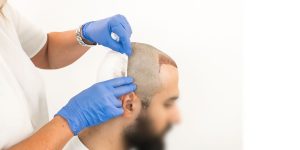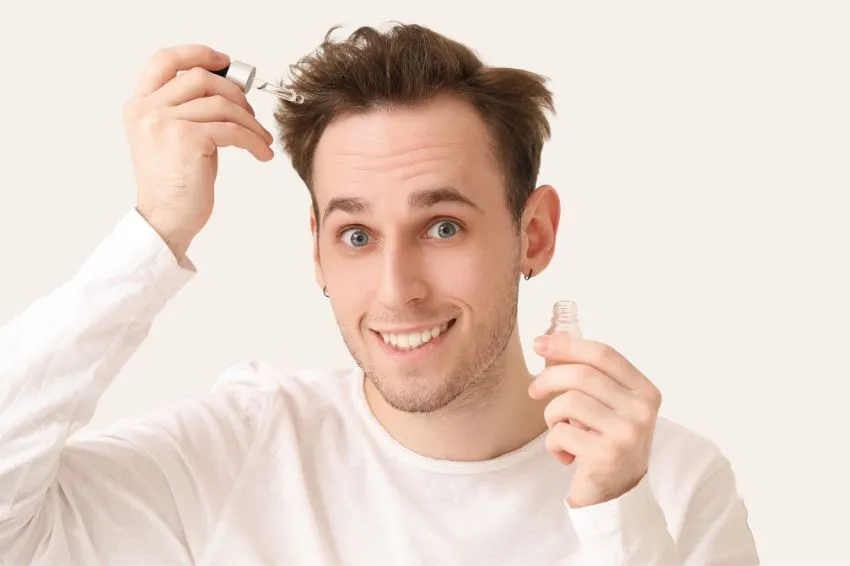Pre-Post Hair Transplant Guidelines
Navigating a hair transplant journey requires careful preparation and aftercare to ensure the best results. Pre-Post Hair Transplant guidelines are essential in preparing your scalp for the procedure and supporting optimal healing afterward. These guidelines provide vital steps to follow before and after your transplant, helping to maximize the success of the surgery and promote healthy, natural hair growth. By adhering to these Pre-Post Hair Transplant instructions, you can confidently approach your procedure with the knowledge that you are doing everything possible to achieve the best outcome.
Table of Contents
TogglePre-Operation Guidelines:
To ensure a smooth and successful hair transplant procedure, there are several important steps
you must take in the week leading up to your appointment:
• Avoid Alcohol
Refrain from consuming any alcohol for at least seven days prior to the
hair transplant procedure. Alcohol can interfere with the healing process and increase the risk of
complications.
• Discontinue Blood Thinners
If you are taking blood-thinning medications, such as
aspirin, it is crucial to stop these, but only after consulting with your doctor. Additionally, if you
have conditions such as high blood pressure or heart disease, you must obtain written approval
from your doctor before proceeding with the hair transplant.
• Inform About Hair Loss Treatments
If you are using other treatments for hair loss,
such as minoxidil or finasteride, please inform our team before your visit.
• Pre-Procedure Nutrition
Since the hair transplantation is performed under local
anesthesia, it is essential to have a nutritious breakfast on the day of the procedure. However,
avoid drinking coffee or tea; instead, opt for natural juices like orange juice, which are more
beneficial.
Day of Procedure
Upon arrival at the hospital on the day of your procedure, several important steps will be taken:
• Blood Tests
We will conduct a series of blood tests. The first is a rapid test to check for
any infectious diseases that might necessitate postponing the procedure; results are available
within 15 minutes. The second test takes two and a half to three hours and helps us understand
the cause of your hair loss. While the rapid test is sufficient to start the procedure, the results of
the second test will inform post-operative treatment.
• Drawing and Preparation:
The doctor will outline the transplant areas, including the
hairline and donor area. Local anesthesia will then be administered to the donor area, and
follicular units will be extracted using the FUE (Follicular Unit Extraction) technique. The
channels are then opened in the bald area, and the harvested follicles are carefully
transplanted.
• Patient Comfort
Since the procedure is performed under local anesthesia, you will be
able to move during the operation, such as going to the bathroom or taking a break for lunch.
This helps to keep you comfortable throughout the process.

Post-Operation Care
Following the completion of the hair transplant, the donor area will be bandaged, and you will
be given specific instructions to ensure the success of your transplant:
• Protecting the Transplanted Area
The transplanted follicles are delicate and not yet
firmly rooted. When getting in or out of a car, or moving around the hotel, be extremely cautious
not to let the transplanted area touch any surfaces such as the car roof, doors, or walls.
• Avoid Lowering Your Head
After the procedure, the transplanted area will contain
some serum. Avoid lowering your head, as this can cause the fluid to move to your face, leading
to swelling around the eyes. It is especially important to avoid looking down at your phone. To
help flush the serum from your body, drink plenty of water during the first three days.
• Medication Adherence
It is critical to follow the prescribed medication regimen
immediately after the operation. Our team will provide detailed instructions on how to take your
medications.
Sleeping Position
In the first ten days after the hair transplant, the newly transplanted follicles are not yet fixed in
place. To protect them:
• Sleep on Your Back
Lie on your back with an additional pillow under the donor area,
which has been bandaged by the doctor. This elevation will help prevent the transplanted area
from rubbing against the pillow or mattress.
• Minimize Movement
Try not to turn to your right or left while sleeping to avoid
disturbing the transplanted follicles.
Post-Procedure Observations:
The morning after the procedure, you may notice some fluid discharge from the donor area,
which might be yellow or tinged with red. This is a normal response, as the doctor will have
applied an anti-inflammatory cream before bandaging the area.
Post-Hair Transplant Care
The Day After Hair Transplantation:
The day following your hair transplant, we will take you to
the hospital to remove the bandage and perform the first hair wash. After this, you can either
return home or choose to stay in Istanbul.
How to Wash Your Hair After Hair Transplantation:
Proper hair washing is crucial to ensure the success of your hair transplant. Please follow these
instructions carefully:
• Starting Hair Washing
Begin washing your hair on the third day after the procedure,
not counting the initial wash we perform for you the day after the surgery. For example, if your
operation was on a Monday, you should start your first wash on Wednesday. Wash your hair
once daily before bedtime.
. Hair Washing Process
. Foam Spray: Apply the foam spray only to the area where the hair grafts were
transplanted. Leave it on for 30-45 minutes. When washing it off, gently tap the transplanted
area with your hand to help remove the foam.
. Shampoo:
▪ Donor Area: Apply the shampoo to the donor area and wash it with a normal hand
massage.
▪ Transplanted Area: Foam the shampoo with your hands and apply the foam gently to
the transplanted area. For the first 10 days, only tap lightly without massaging.
- Ensure you use warm water with no pressure. Hot or cold water can damage the
transplanted grafts. - Avoid rubbing or scratching the transplanted area.
- You can use a hair dryer to dry your hair after washing, but it must be on the cold
setting and slightly away from the transplanted area. - If you experience itching or pain in the donor area, you can apply the foam spray to
alleviate it. You can also use a moisturizing skin cream.
Continued Hair Washing
Shampooing should be done daily to remove scabs. By 10 days post-procedure, there should
be no traces of dried blood or scabs on your scalp.
After 11 days, you can start washing your hair normally. If needed, you can wash your hair more
than once a day. Continue using the special shampoo provided until the bottle is empty.
Afterward, switch to a herbal shampoo that is free of chemicals and continue using it for about
six months post-operation.
After washing, dry your hair with a paper towel. Do not rub; instead, pat it very gently.
Moisturizer should be used until the scabs fall off or if your scalp feels dry. Apply it by dabbing
only, without massaging. You can also use the moisturizer between washes if dryness persists.
Post-Wash Care
How to wash the head after hair transplant
• After the 11th Wash
You can start gently massaging the transplanted area, gradually
increasing the intensity each day.
• After the 15th Wash
Take pictures of your hair from different angles and send them to
us for a doctor’s review.
Immediate Post-Procedure Care
• Sleep Position
During the first week, ensure you lie on your back when sleeping.
• Smoking
It’s important to avoid smoking for the first three days after your procedure.
• Alcohol and Sexual Activity
Steer clear of alcohol consumption and sexual activity during this time.
intercourse for the first seven days. Additionally, avoid dusty environments and protect your
head from any impacts.
• Physical Activities
Avoid sports, fitness activities, steam baths, swimming, and
sunbathing for the first month after the procedure.
Avoid bending, lifting, or straining for one week after your procedure. Strenuous activity could
lead to swelling, bleeding, and graft loss. Keep physical activity to a minimum. When lifting
objects or tying your shoes, bend at the knees instead of the waist.
Light Exercise
You can begin short walks or very light physical exercises that do not cause
sweating 10 days post-operation. However, it is recommended to shower shortly after workouts
to minimize the risk of infection. Avoid swimming, gym workouts, bodybuilding, or any fitness
exercises for one month post-operation.
• Haircuts
For the first six months, use scissors for haircuts instead of clippers, as
clippers can damage the new hair. Hair coloring can be done after six months.
• Post-Procedure Symptoms
It is normal to experience itching, pain, and swelling during the first ten days. These symptoms should gradually subside.
Hair Growth Timeline
• Donor Area Recovery
The donor area at the back of your head will return to its original
density within 2-6 weeks.
• Hair Growth
The implanted hairs will start to grow approximately 3-4 months after the
procedure. By 6 months, about 70% of the hair growth will be complete, and by 12 months, the
growth will reach 100%. However, it may take up to 1.5 years for hair transplanted in the apex
(crown) area to achieve maximum results.
Scarring After the Operation
• No Scarring
There will be no scars left in the area where the hair roots were taken. Any
redness in this area should disappear within 15 days to one month. The FUE (Follicular Unit
Extraction) system’s major advantage is that it leaves no scars.
Protecting and Supporting Your Hair:
• Preventing Hair Loss
To help protect your original hair from future hair loss and to
support the newly transplanted hair follicles, we recommend using ClinMedica Support
Products.
ClinMedica Hair Treatment Suggestions:
• PRP Treatment
Platelet-Rich Plasma (PRP) therapy helps to rejuvenate damaged scalp
cells, enabling them to absorb nutrients and vitamins more effectively. This is the primary
function of PRP.
• Additional Treatment – PRP + AGF-39
The doctor may recommend a combination of
PRP therapy and AGF-39 (Autologous Growth Factor) to not only heal damaged cells but also
to prevent future hair loss and stimulate the newly transplanted hair follicles to produce faster
and stronger hair.
Role of Growth Factors in Hair Loss Treatment:
• AGF-39 (Autologous Growth Factor)
AGF-39 contains essential vitamins that are
crucial for increasing hair density and promoting new hair growth. Its unique formula is directly
involved in the hair growth hormone, ensuring the benefits are targeted specifically to the hair,
unlike other vitamins that may be used elsewhere in the body.
Aftercare and Communication
• Stay in Touch
After your hair transplant, it is vital to stay in regular contact with our
Aftercare Department. Send photos every 15 days to allow our team to monitor your progress
and provide you with advice and instructions at every stage of your hair growth journey.

